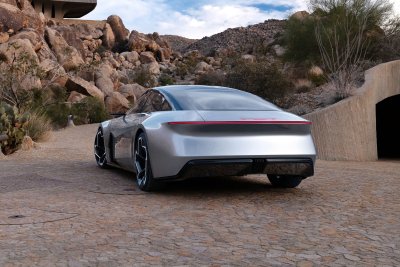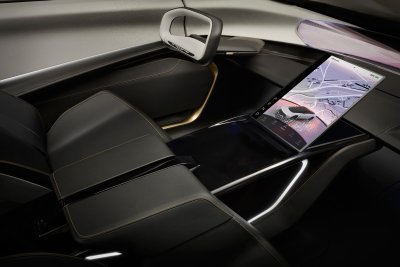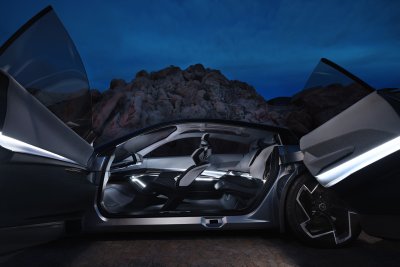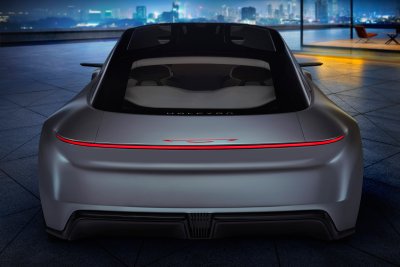With only the Pacifica minivan on the market today, the Chrysler brand is in crisis mode as it works to regain relevance among the buying masses. The just-revealed Chrysler Halcyon Concept battery-electric car is a step in that direction.
It follows other concepts that have been revealed in recent years, including the Chrysler Portal Concept (2017), the Chrysler Airflow Concept (2022) and the Chrysler Synthesis Cockpit Demonstrator (2023). No version of those models has come to market yet.
"We opened this up to the entire design office and we wanted to see how far they could take it. The designers were so excited, and we had probably the largest amount of sketches that we could pull from," Irina Zavatski, Vice President of Chrysler Exterior Design at Stellantis North America told Newsweek at a press event in metro Detroit.
"And then from that point on, we started to make it into a vehicle. So it's absolutely uncompromised in design and sustainability. It's not only coming through materials, but also through the simplicity of it. There's absolutely nothing here that doesn't need to be."
The Halycon sedan is built on 800-volt architecture that is similar to what Kia uses in the EV6 and EV9.
Its low-slung body design plays on supercar styling. The model sits just 4 inches off the ground and features aero blade air pass-throughs that minimize wind resistance and enhance efficiency leading to more battery-electric range.


The concept car has suicide-style rear-hinged rear doors and a butterfly-hinged canopy, opening up the cabin for easy entry and exit, which also raises the suspension. The rear seats, in a nod to the Pacifica's Stow-and-Go, retract into the truck area for more storage.
Its windshield extends out to the edges of the vehicle for an expansive view of the road and sky. Chrysler Wing logos on the aero blades illuminate as the driver approaches, and display the vehicle's charge level.
The concept rides on lightweight, machine-faced 22-inch wheels with turbine-shape design and low-rolling resistance Pirelli tires.
At its rear, the width of the vehicle is emphasized, and another LED Chrysler logo is featured.
Active aerodynamic controls, including a sliding rear lower aero diffuser created from lightweight composite material, a rear spoiler and air suspension work to enhance the car's drivability.
It also incorporates inductive charging technology, meaning it can recharge on special wireless charging roads or via an installed charging pad. The technology is not yet in wide use, but trials have been ongoing across the world.
The cabin is meant to be a digital detox, says Chrysler, though it features a 15.6-inch touchscreen infotainment console that can be rotated to portrait or landscape orientations, similar to how the Fisker Ocean's screens operate, and it can be stowed out of sight.


It complements the pillar-to-pillar transparent display, which allows users to see information and keep their eyes on the road. BMW has featured similar technology in its Vision concept cars.
Chrysler is using the concept to show off the lifestyle of a vehicle owner once SAE Level 4 hands-free driving technology comes to market. Called STLA AutoDrive, the tech would allow drivers to lean back and relax will being driven, using the AI voice assistant and augmented reality to do things like listen to music and stargaze.
The squared steering wheel and pedals would also retract leaving more space for occupants. Other automakers have shown similar styling, like in the MINI Urbanaut concept minivan.
Chrysler has designed the Halcyon Concept to be sustainable and recyclable, using materials like wood and recycled plastics throughout the model. Composite material made from used compact discs was utilized to create the sparkly Chrysler logo.
"It's not just about taking materials we know and making them sustainable. For us it was finding materials that really have the quality, the cues, the look and feel that they are sustainable. So we have our Solar White color throughout the top that's suede, made from 73-percent plastic bottles. All the materials you see in the interior are synthetic, so no leather throughout the interior," Ryan Nagode, Vice President of Interior Design at Stellantis said.


"We have 100-percent recycled content within our fabrics. There's not a lot of paint as we're trying to lower the nitrous oxide (NOx) levels in terms of our carbon footprint. One of the other elements is our is a textile infused wood that's through the floor area goes into the trunk. The beauty about that wood is it's traceable," he said.
The Halcyon Concept shows off use cases for personalized technology that is able to deliver predictive navigation points for a driver's daily journeys, biometric identification for locking and unlocking, and personalized greeting sounds.
Occupants can also watch their favorite movies and play games on the car's glass, which comprises 45 percent of the exterior, rather than relying on screens to project images to the cabin.
The luxury concept is part of the company's Dare Forward 2030 plan, which aims to cut the Stellantis global carbon footprint by 50 percent by 2030, on its way to net carbon zero by 2038. Chrysler plans to launch its first EV in 2025 and the brand will be all-electric by 2028.
"Chrysler — a brand offering only a single vehicle, the Pacifica minivan — is at a turning point that requires a new identity as it shapes its future portfolio. The Halcyon Concept envisions forward-thinking technologies where the brand could go, transitioning to electric vehicles and reshaping the personal mobility experience," Paul Waatti, manager of industry analysis at AutoPacific told Newsweek.
"The concept draws very little from Chrysler's history, perhaps what is needed as the brand redefines itself for a revival in the second half of the decade."
Uncommon Knowledge
Newsweek is committed to challenging conventional wisdom and finding connections in the search for common ground.
Newsweek is committed to challenging conventional wisdom and finding connections in the search for common ground.
About the writer
Jake Lingeman is the Managing Editor for the Autos team at Newsweek. He has previously worked for Autoweek, The Detroit ... Read more





